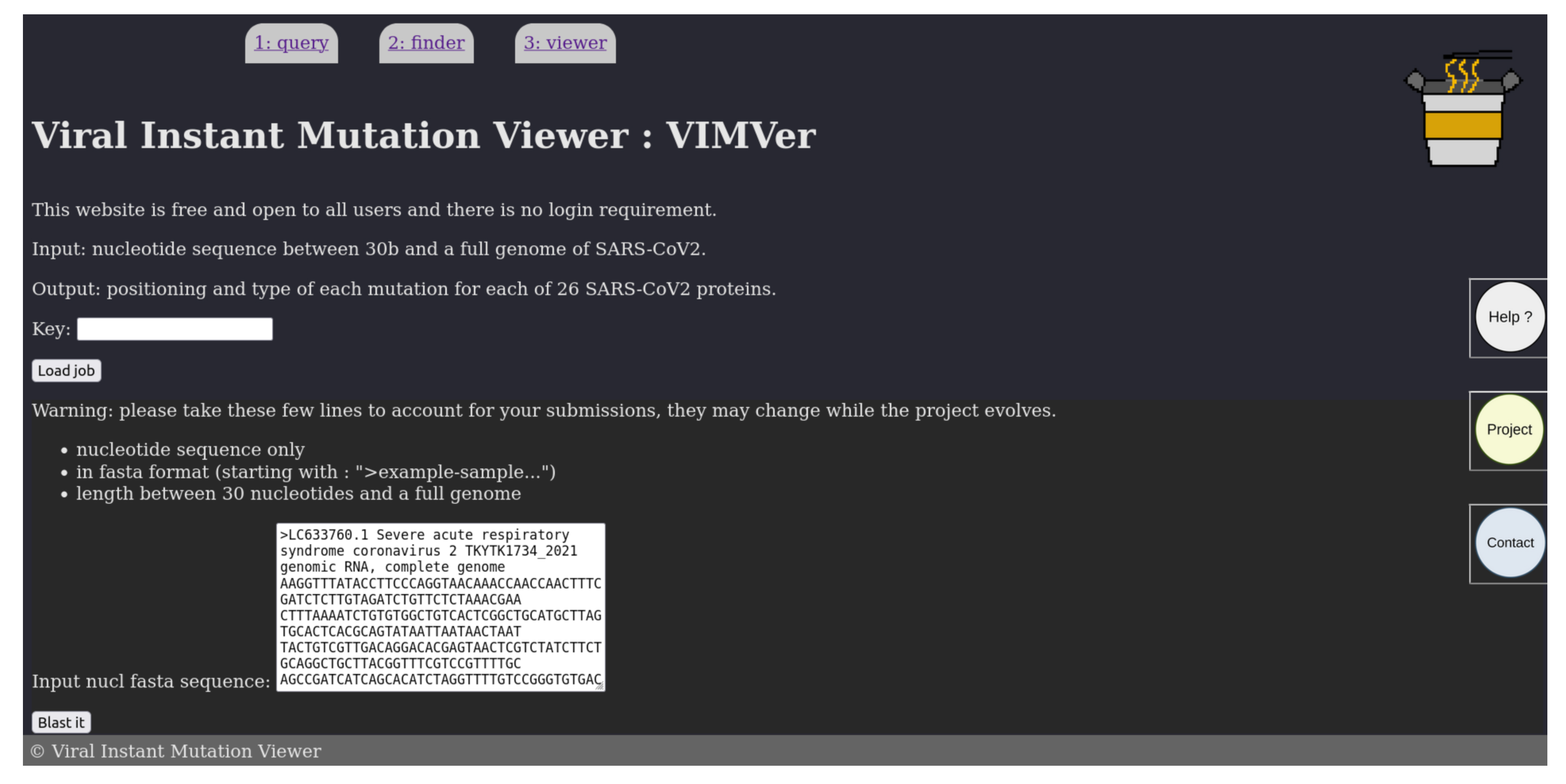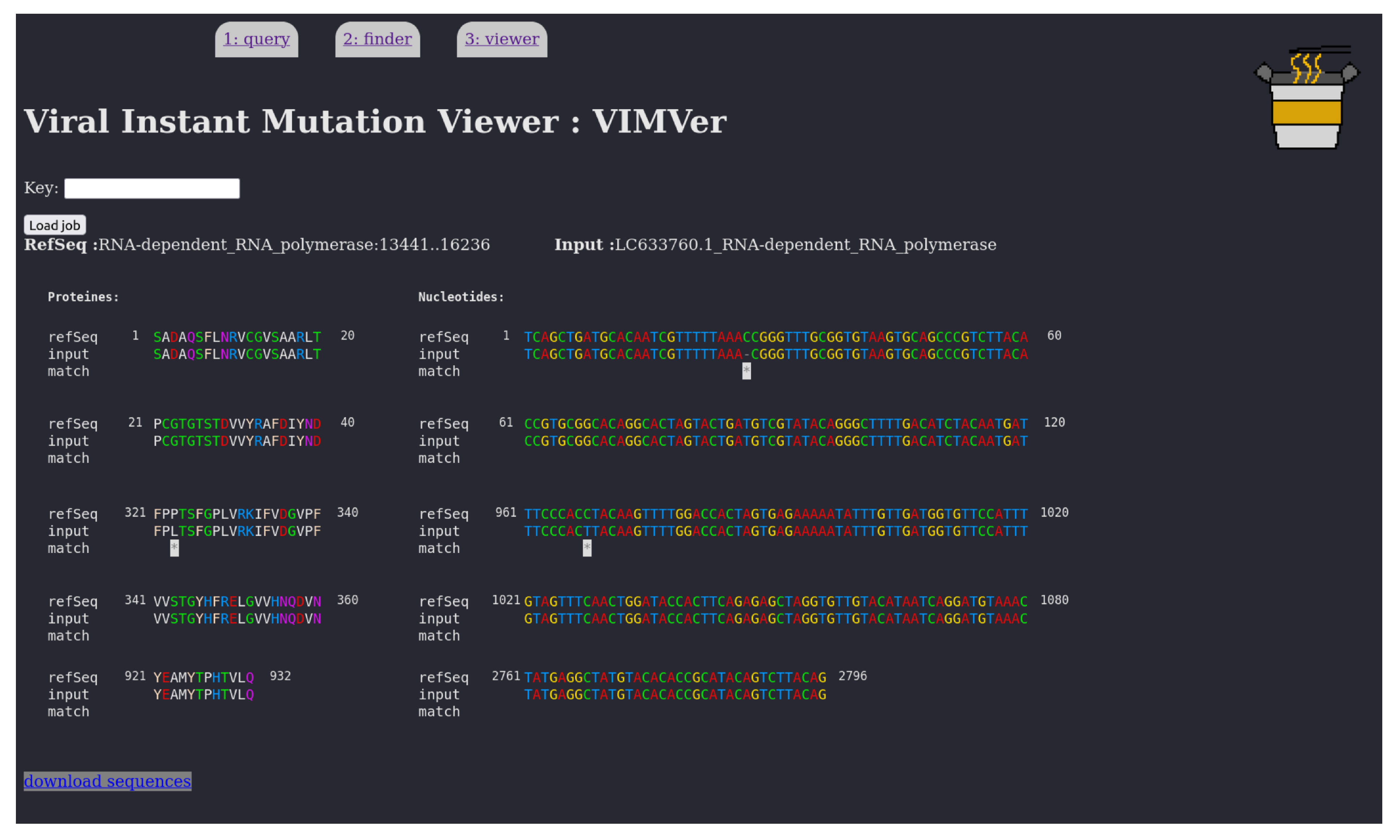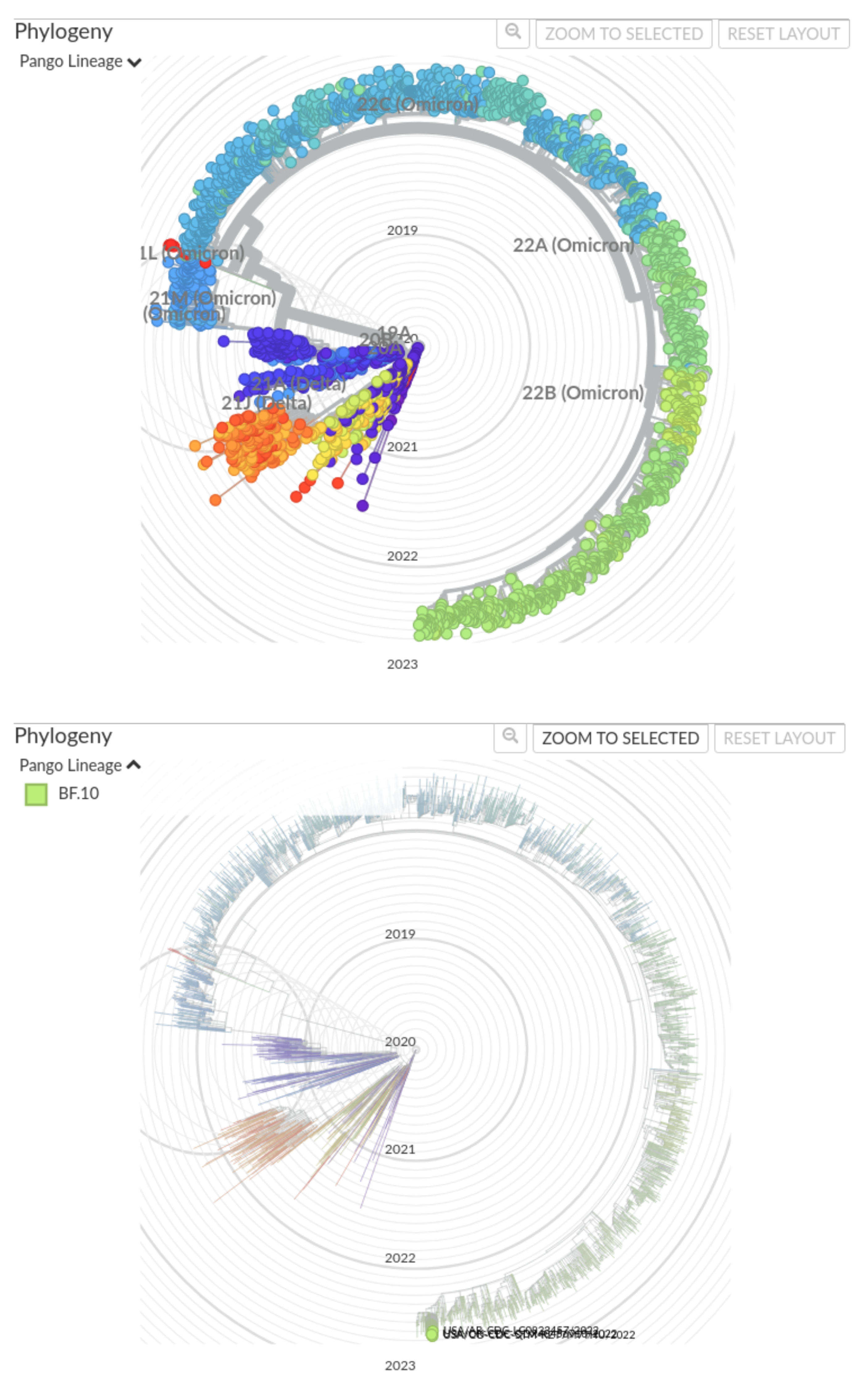Viral Instant Mutation Viewer: A Tool to Speed Up the Identification and Analysis of New SARS-CoV-2 Emerging Variants and Beyond
Abstract
1. Introduction
2. Materials and Methods
2.1. Database
2.2. Search Engine and Alignments
2.3. Accessibility
2.4. Deployment
3. Results
3.1. Web Interface and Practical Example
3.2. Benchmark
4. Discussion
5. Conclusions
Supplementary Materials
Author Contributions
Funding
Institutional Review Board Statement
Informed Consent Statement
Data Availability Statement
Acknowledgments
Conflicts of Interest
Abbreviations
| VIMVer | Viral Instant Mutation Viewer |
| SARS-CoV-2 | Severe acute respiratory syndrome coronavirus 2 |
| COVID-19 | Coronavirus disease 2019 |
| CoV | Coronavirus |
| NCBI | National center of biotechnology information |
| GISAID | Global Initiative on Sharing All Influenza Data |
| NGS | next-generation sequencing |
| VOCs | variants of concern |
| ORF# | open reading frame #number |
| pp# | polyprotein #number |
| nsp# | non-structural protein #number |
| ssl | Secure Sockets Layer certificate |
| RdRp | RNA-dependant RNA-polymerase |
| RNA | ribonucleic acid |
References
- Sohrabi, C.; Alsafi, Z.; O′Neill, N.; Khan, M.; Kerwan, A.; Al-Jabir, A.; Iosifidis, C.; Agha, R. World Health Organization declares global emergency: A review of the 2019 novel coronavirus (COVID-19). Int. J. Surg. 2020, 76, 71–76. [Google Scholar] [CrossRef] [PubMed]
- Fehr, A.R.; Perlman, S. Coronaviruses: An Overview of Their Replication and Pathogenesis. Coronaviruses 2015, 1282, 1. [Google Scholar] [CrossRef]
- Aksamentov, I.; Roemer, C.; Hodcroft, E.; Neher, R. Nextclade: Clade assignment, mutation calling and quality control for viral genomes. J. Open Source Softw. 2021, 6, 3773. [Google Scholar] [CrossRef]
- Altschul, S.F.; Gish, W.; Miller, W.; Myers, E.W.; Lipman, D.J. Basic local alignment search tool. J. Mol. Biol. 1990, 215, 403–410. [Google Scholar] [CrossRef] [PubMed]
- Edgar, R.C. MUSCLE: Multiple sequence alignment with high accuracy and high throughput. Nucleic Acids Res. 2004, 32, 1792–1797. [Google Scholar] [CrossRef] [PubMed]
- Bhatt, P.R.; Scaiola, A.; Loughran, G.; Leibundgut, M.; Kratzel, A.; Meurs, R.; Dreos, R.; O′Connor, K.M.; McMillan, A.; Bode, J.W.; et al. Structural basis of ribosomal frameshifting during translation of the SARS-CoV-2 RNA genome. Science 2021, 372, 1306–1313. [Google Scholar] [CrossRef]
- Nuin, P.A.S.; Wang, Z.; Tillier, E.R.M. The accuracy of several multiple sequence alignment programs for proteins. BMC Bioinf. 2006, 7, 471. [Google Scholar] [CrossRef] [PubMed]
- O′Toole, Á.; Pybus, O.G.; Abram, M.E.; Kelly, E.J.; Rambaut, A. Pango lineage designation and assignment using SARS-CoV-2 spike gene nucleotide sequences. BMC Genom. 2022, 23, 121. [Google Scholar] [CrossRef] [PubMed]
- Harvey, W.T.; Carabelli, A.M.; Jackson, B.; Gupta, R.K.; Thomson, E.C.; Harrison, E.M.; Ludden, C.; Reeve, R.; Rambaut, A.; COVID-19 Genomics UK (COG-UK) Consortium; et al. SARS-CoV-2 variants, spike mutations and immune escape. Nat. Rev. Microbiol. 2021, 19, 409. [Google Scholar] [CrossRef] [PubMed]
- Plant, E.P.; Dinman, J.D. The role of programmed-1 ribosomal frameshifting in coronavirus propagation. Front. Biosci. J. Virtual Libr. 2023, 13, 4873. [Google Scholar] [CrossRef] [PubMed]
- Ferron, F.; Rancurel, C.; Longhi, S.; Cambillau, C.; Henrissat, B.; Canard, B. VaZyMolO: A tool to define and classify modularity in viral proteins. J. Gen. Virol. 2005, 86, 743–749. [Google Scholar] [CrossRef] [PubMed]
- Uversky, V.N.; Dunker, A.K. Understanding Protein Non-Folding. Biochim. Biophys. Acta 2010, 1804, 1231. [Google Scholar] [CrossRef]
- Gorbalenya, A.E.; Lieutaud, P.; Harris, M.R.; Coutard, B.; Canard, B.; Kleywegt, G.J.; Kravchenko, A.A.; Samborskiy, D.V.; Sidorov, I.A.; Leontovich, A.M.; et al. Practical application of bioinformatics by the multidisciplinary VIZIER consortium. Antivir. Res. 2010, 87, 95. [Google Scholar] [CrossRef]
- Imbert, I.; Snijder, E.J.; Dimitrova, M.; Guillemot, J.C.; Lécine, P.; Canard, B. The SARS-Coronavirus PLnc domain of nsp3 as a replication/transcription scaffolding protein. Virus Res. 2008, 133, 136. [Google Scholar] [CrossRef] [PubMed]
- Coutard, B.; Gorbalenya, A.E.; Snijder, E.J.; Leontovich, A.M.; Poupon, A.; De Lamballerie, X.; Charrel, R.; Gould, E.A.; Gunther, S.; Norder, H.; et al. The VIZIER project: Preparedness against pathogenic RNA viruses. Antivir. Res. 2008, 78, 37. [Google Scholar] [CrossRef] [PubMed]
- John, S.P.; Wang, T.; Steffen, S.; Longhi, S.; Schmaljohn, C.S.; Jonsson, C.B. Ebola Virus VP30 Is an RNA Binding Protein. J. Virol. 2007, 81, 8967. [Google Scholar] [CrossRef] [PubMed]
- Radivojac, P.; Iakoucheva, L.M.; Oldfield, C.J.; Obradovic, Z.; Uversky, V.N.; Dunker, A.K. Intrinsic Disorder and Functional Proteomics. Biophys. J. 2007, 92, 1439. [Google Scholar] [CrossRef]
- Habchi, J.; Mamelli, L.; Darbon, H.; Longhi, S. Structural Disorder within Henipavirus Nucleoprotein and Phosphoprotein: From Predictions to Experimental Assessment. PLoS ONE 2010, 5, e11684. [Google Scholar] [CrossRef]
- Ogola, E.O.; Kopp, A.; Bastos, A.D.S.; Slothouwer, I.; Marklewitz, M.; Omoga, D.; Rotich, G.; Getugi, C.; Sang, R.; Torto, B.; et al. Jingmen Tick Virus in Ticks from Kenya. Viruses 2022, 14, 1041. [Google Scholar] [CrossRef] [PubMed]
- Jumper, J.; Evans, R.; Pritzel, A.; Green, T.; Figurnov, M.; Ronneberger, O.; Tunyasuvunakool, K.; Bates, R.; Žídek, A.; Potapenko, A.; et al. Highly accurate protein structure prediction with AlphaFold. Nature 2021, 596, 583. [Google Scholar] [CrossRef] [PubMed]





Disclaimer/Publisher’s Note: The statements, opinions and data contained in all publications are solely those of the individual author(s) and contributor(s) and not of MDPI and/or the editor(s). MDPI and/or the editor(s) disclaim responsibility for any injury to people or property resulting from any ideas, methods, instructions or products referred to in the content. |
© 2023 by the authors. Licensee MDPI, Basel, Switzerland. This article is an open access article distributed under the terms and conditions of the Creative Commons Attribution (CC BY) license (https://creativecommons.org/licenses/by/4.0/).
Share and Cite
Wilde, V.; Canard, B.; Ferron, F. Viral Instant Mutation Viewer: A Tool to Speed Up the Identification and Analysis of New SARS-CoV-2 Emerging Variants and Beyond. Viruses 2023, 15, 1628. https://doi.org/10.3390/v15081628
Wilde V, Canard B, Ferron F. Viral Instant Mutation Viewer: A Tool to Speed Up the Identification and Analysis of New SARS-CoV-2 Emerging Variants and Beyond. Viruses. 2023; 15(8):1628. https://doi.org/10.3390/v15081628
Chicago/Turabian StyleWilde, Vincent, Bruno Canard, and François Ferron. 2023. "Viral Instant Mutation Viewer: A Tool to Speed Up the Identification and Analysis of New SARS-CoV-2 Emerging Variants and Beyond" Viruses 15, no. 8: 1628. https://doi.org/10.3390/v15081628
APA StyleWilde, V., Canard, B., & Ferron, F. (2023). Viral Instant Mutation Viewer: A Tool to Speed Up the Identification and Analysis of New SARS-CoV-2 Emerging Variants and Beyond. Viruses, 15(8), 1628. https://doi.org/10.3390/v15081628





